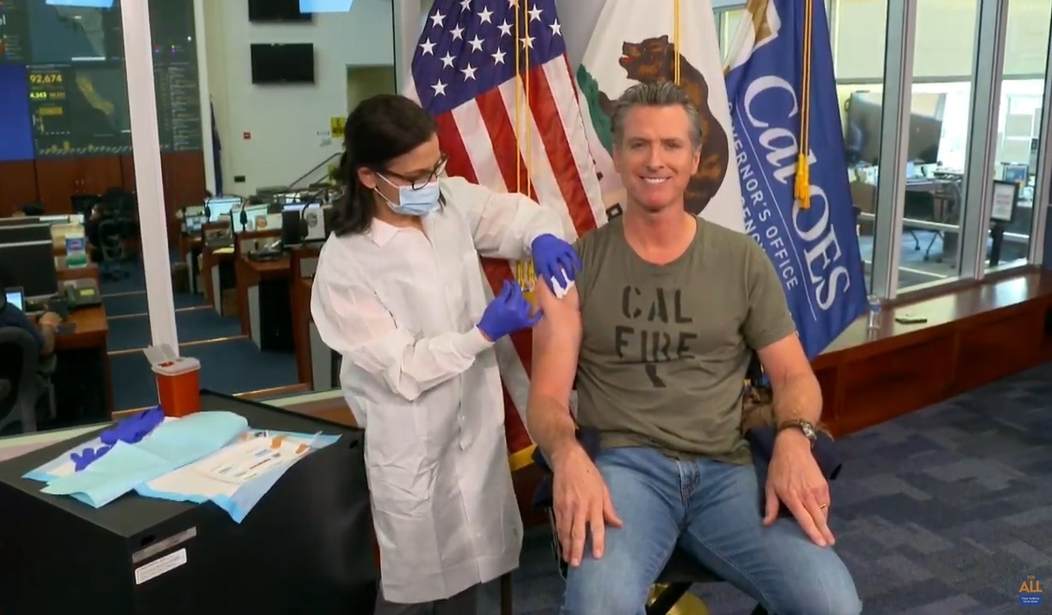As I reported last week, California Gov. Gavin Newsom (D-Private Jet to Montana) decided to add a “Health Equity Measure” to the state’s “Blueprint for a Safer Economy,” a/k/a reopening requirements. This was done without the input of the legislature but, according to sources, with help from and the full buy-in of the state’s equity-minded public health officials, including Los Angeles County’s “Not That Kind of Doctor,” Barbara Ferrer, Ph.D.
(Note: In public health terms, “equity” is defined by the Robert Wood Johnson Foundation as meaning “that everyone has a fair and just opportunity to be as healthy as possible. This requires removing obstacles to health such as poverty, discrimination, and their consequences, including powerlessness and lack of access to good jobs with fair pay, quality education, and housing, safe environments, and health care.”)
Newsom’s newest Social Justice metric (conveniently timed with the release of his wife’s new documentary that focuses on “equity issues”) is irrelevant, ridiculous, and a massive overstepping of emergency powers.
The California Department of Public Health website explains that while a county might meet the two metrics of case rate and positivity rate overall, if the economy reopens there will be “mixing” between “more and less advantaged neighborhoods” and if that happens transmission could increase (emphasis mine).
Most counties have significant differences in test positivity among more and less advantaged neighborhoods, with these differences often also overlapping with race and likelihood of employment as essential workers. Especially as counties move into less restrictive tiers with more movement, the importance of this differential prevalence of infection grows because mixing and opportunities for transmission increase. Therefore, it is imperative to reduce disease transmission in all communities to ensure California reopens its economy safely.
Public health officials argue that essential workers are more likely to live in less advantaged neighborhoods as part of the basis for this “health equity” requirement. I’m sure they have some Kellogg Foundation-backed study to back up that assertion, but it’s not necessarily true. Doctors, nurses, EMTs, firemen, and policemen, in general, don’t live in the “less advantaged” census tracts defined by California’s Equity Metric. Regardless, they’ve been “mixing” throughout every neighborhood for the duration of the pandemic, as have other essential workers – many of whom do not live in the communities in which they work.
But, hey, logic was never meant to co-exist with social justice warrior-ing.
In order to advance to the next less restrictive tier, counties with a population of over 106,000 will have to meet the Equity Metric, as defined:
In addition, the county’s lowest quartile Healthy Places Index (HPI) census tracts must also meet the specified test positivity threshold, as described below, for the less restrictive tier during those same weeks.
- For counties entering the red tier, their lowest quartile HPI census tracts’ test positivity must also be ≤8%
- For counties entering the orange tier, their lowest quartile HPI census tracts’ test positivity must be within 5% of the orange tier threshold, or ≤5.2%
- For counties entering the yellow tier, their lowest quartile HPI census tracts must be within 10% of the yellow tier threshold, or ≤2.1%
In addition, they must:
Submit a plan that (1) defines its disproportionately impacted populations, (2) specifies the percent of its COVID-19 cases in these populations, and (3) shows that it plans to invest Epidemiology and Laboratory Capacity for Prevention and Control of Emerging Infectious Diseases (Strategy 5: Use Laboratory Data to Enhance Investigation, Response, and Prevention) grant funds at least at that percentage to interrupt disease transmission in these populations. The targeted investments can include spending on augmenting testing, disease investigation, contact tracing, isolation/quarantine support, and education and outreach efforts for workers.
Wouldn’t a county public health department already target investments and grant dollars toward communities that are more greatly impacted by a certain disease? Why is this necessary?
And, what exactly is the Healthy Places Index? Is it really such a big deal?
As usual, FOX LA’s Bill Melugin had a great tweet thread about some of the things that the HPI measures:
The state will incorporate the California “Healthy Places Index” (HPI) into its decision making for county reopenings. The HPI measures numerous things, including two parent households, voting, alcohol availability, retail density, clean air & water, and "tree canopy". @FOXLA pic.twitter.com/4Llw01rng6
— Bill Melugin (@BillFOXLA) October 6, 2020
Yes, a few of the things that earn a census tract a lower score on the HPI are the number of two-parent households, the number of people who rent versus own a home, the amount of “tree canopy” available, retail density, and how many of the people there vote. Among the factors not considered: crime, vagrancy, drug abuse, and homelessness.
Some counties haven’t kept detailed records on each person with a positive Wuhan flu diagnosis, to be able to assign them to a census tract and will have to go back and build out the data for each diagnosis, then figure out what percentage of their COVID cases are within that lowest quartile on the HPI before they can even submit plans to “spend on augmenting testing, disease investigation, contact tracing, isolation/quarantine support, and education and outreach efforts for workers.” And how will this all be accomplished? Of course, the CA Department of Public Health has them covered with (again, emphasis mine):
“[A] menu of best practices, resources, and vendors with an equity focus to share and provide resources to counties.”
Just who are those vendors, and which politicians and public health “experts” are they tied to?
None of this is related to reopening “successfully,” whatever that means. This is entirely an end run around normal policy development and enactment by public health officials who have been outed as not knowing very much about epidemiology and who have an agenda to push.















Join the conversation as a VIP Member